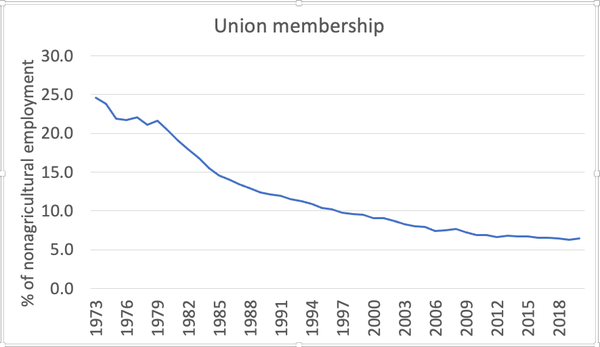What follows is based on a piece published to private subscribers by Nobel Laureate Economist Paul Krugman.
Joe Biden gave a speech on Sunday that could be a beacon of light for unions after forty-plus years in darkness. He spoke via video expressing solidarity with Amazon workers in Alabama, who are attempting to unionize one of the retail giant’s facilities. He was careful not to say which way they should vote. But he defended their right to hold such a vote, and warned Amazon (without naming the company) that “there should be no intimidation, no coercion, no threats, no anti-union propaganda.”
This may signal a major change in policy regarding labor law enforcement.
We used to be a nation with powerful unions. In the early 1970s roughly a quarter of nonfarm workers in the private sector were union members, not too far short of the 35 percent unionization rate in the mid-1950s. And even companies without unions tread carefully because they knew that playing hardball with their workers could easily lead to a unionization drive.
These days, however, while unions are still influential in the public sector, private-sector unions have all but disappeared:

Why did this happen? You often hear assertions to the effect that globalization killed the labor movement, because unionized firms couldn’t cope with international competition.
But this story doesn’t hold up in the face of the facts. First, while unions have lost some ground in many countries, the collapse of organized labor in America is unique. Denmark is every bit as integrated with the global economy as we are, yet two-thirds of its workers are union members. A quarter of Canadian workers are unionized, which is only a modest decline from the proportion half a century ago.
Also, while a global competition story might seem to make sense for manufacturing firms, there’s no reason unions have to be restricted to manufacturing. These days America’s biggest private employers are Walmart, Amazon, Kroger and Home Depot. (Amazon may look to consumers like a virtual company that exists only in cyberspace, but those quick deliveries are made possible by more than a million workers, mainly employed in a vast network of warehouses, and a complex delivery system.)
And the services provided by today’s giant service-sector companies aren’t subject to global competition: You can’t get two-day delivery or fresh produce from a factory in Guangzhou. There is, in other words, no inherent economic reason for the implosion of the U.S. labor movement.
So what did happen? Politics. Unions could have remained an important force in American life, even as we transitioned from a manufacturing to a service economy. But to do so they would have had to organize workers in rapidly growing service companies like Walmart and now Amazon. And they generally failed to do so, because the transition to a service economy took place in an era of conservative political dominance.
It wasn’t so much that the laws protecting union organizing were weak, although to some extent they were. More important, employers trying to block unionization believed, rightly, that the laws wouldn’t be enforced — that they could get away with, as President Biden said, intimidation, threats, coercion and anti-union propaganda.
And the result was that we became a largely nonunion nation, with huge economic and political effects. Unions, while far from being saintly organizations, were by and large a force for higher wages and greater equality. They were also an equalizing force on the political field, because their manpower was an important offset to the power of big money.
Obviously, one speech by a new President won’t reverse all that history. But it was the most pro-union speech given by any modern president, maybe by any president ever. And it might, just might, represent a turning point in American economics and politics.
Share this: